非谓语动词的时态和语态
- 格式:ppt
- 大小:2.75 MB
- 文档页数:52
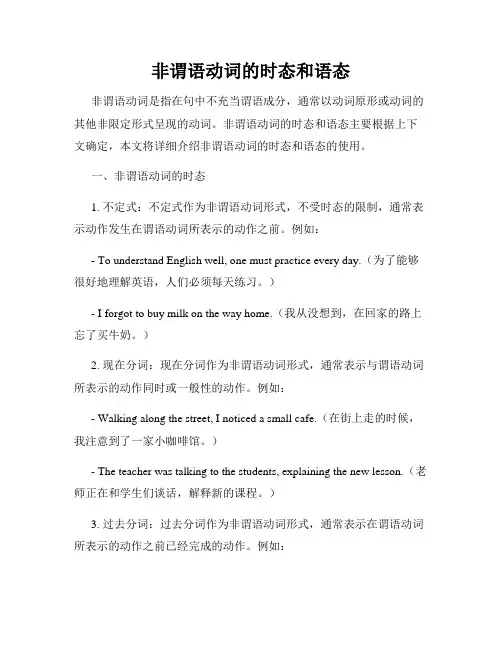
非谓语动词的时态和语态非谓语动词是指在句中不充当谓语成分,通常以动词原形或动词的其他非限定形式呈现的动词。
非谓语动词的时态和语态主要根据上下文确定,本文将详细介绍非谓语动词的时态和语态的使用。
一、非谓语动词的时态1. 不定式:不定式作为非谓语动词形式,不受时态的限制,通常表示动作发生在谓语动词所表示的动作之前。
例如:- To understand English well, one must practice every day.(为了能够很好地理解英语,人们必须每天练习。
)- I forgot to buy milk on the way home.(我从没想到,在回家的路上忘了买牛奶。
)2. 现在分词:现在分词作为非谓语动词形式,通常表示与谓语动词所表示的动作同时或一般性的动作。
例如:- Walking along the street, I noticed a small cafe.(在街上走的时候,我注意到了一家小咖啡馆。
)- The teacher was talking to the students, explaining the new lesson.(老师正在和学生们谈话,解释新的课程。
)3. 过去分词:过去分词作为非谓语动词形式,通常表示在谓语动词所表示的动作之前已经完成的动作。
例如:- Having finished his homework, the boy went out to play.(孩子做完作业后,出去玩了。
)- The injured man was taken to the hospital, accompanied by his family.(受伤的人被他的家人陪同着送到了医院。
)二、非谓语动词的语态非谓语动词的语态主要包括主动语态和被动语态,具体如下:1. 不定式的语态:不定式的语态通常与主句的语态保持一致。
例如:- She wants to be promoted.(她想要升职。
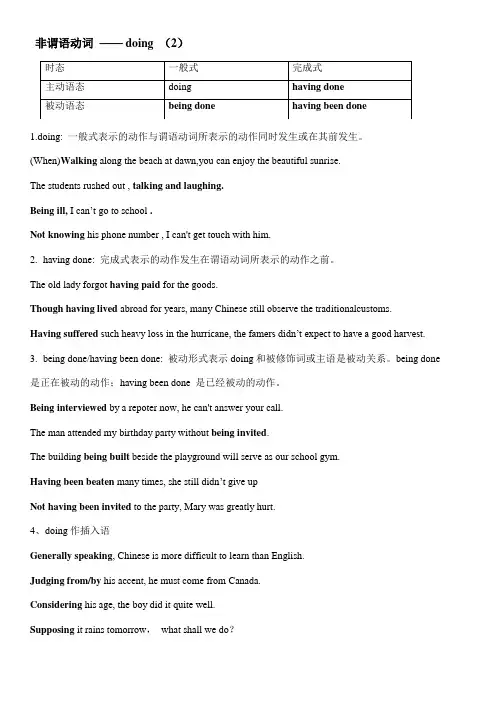
非谓语动词——doing (2)1.doing: 一般式表示的动作与谓语动词所表示的动作同时发生或在其前发生。
(When)Walking along the beach at dawn,you can enjoy the beautiful sunrise.The students rushed out , talking and laughing.Being ill, I can’t go to school .Not knowing his phone number , I can't get touch with him.2.having done: 完成式表示的动作发生在谓语动词所表示的动作之前。
The old lady forgot having paid for the goods.Though having lived abroad for years, many Chinese still observe the traditionalcustoms.Having suffered such heavy loss in the hurricane, the famers didn’t expect to have a good harvest. 3.being done/having been done: 被动形式表示doing和被修饰词或主语是被动关系。
being done 是正在被动的动作;having been done 是已经被动的动作。
Being interviewed by a repoter now, he can't answer your call.The man attended my birthday party without being invited.The building being built beside the playground will serve as our school gym.Having been beaten many times, she still didn’t give upNot having been invited to the party, Mary was greatly hurt.4、doing作插入语Generally speaking, Chinese is more difficult to learn than English.Judging from/by his accent, he must come from Canada.Considering his age, the boy did it quite well.Supposing it rains tomorrow,what shall we do?翻译练习1 He sat there, not daring to say a word.2 The man attended my birthday party without being invited.3 The kind girl ought to be praised instead of being criticized.4 Being watched by strangers now , I feel upset.5 I forgot having given her a call last night.6 The problem being discussed at the meeting is very important.7 Having found the cause,the doctors were able to treat the disease and cure it.8 Having suffered such heavy loss in the hurricane, the famers didn’t expect to have a good harvest.9 Though having lived abroad for years, many Chinese still observe the traditional customs.10 Not having received a reply, he wrote again to ask about what was going on.11 Not having completed the programme, we had to stay there for another two weeks.12 The storm left, having caused a lot of damage to the area.13 The old man, having been abroad for 20 years, is on the way to his homeland.14 Having been told many times , she finnally undstood it.15 Having been warned again and again, the student still w ouldn’t realize his mistake.16 Having been shown around the Ware Cube, we were taken to see the Bird’s Nest.17 Not having been invited to the party, the woman felt very unhappy.18 Not having been told the extra departure time, I missed the flight.19 Never having been praised by his teacher , the student gradually lost interest in study.20 For many older people, particularly those living alone or in the country, driving is important for preserving their independence, giving them the freedom to get out and about without having to rely on others.句意:对于很多老年人来说,特别是那些独自居住在乡间的老年人,驾驶对于保持他们(老年人)的独立性是非常重要的,这也给了他们出行而不用依赖他人的自由。

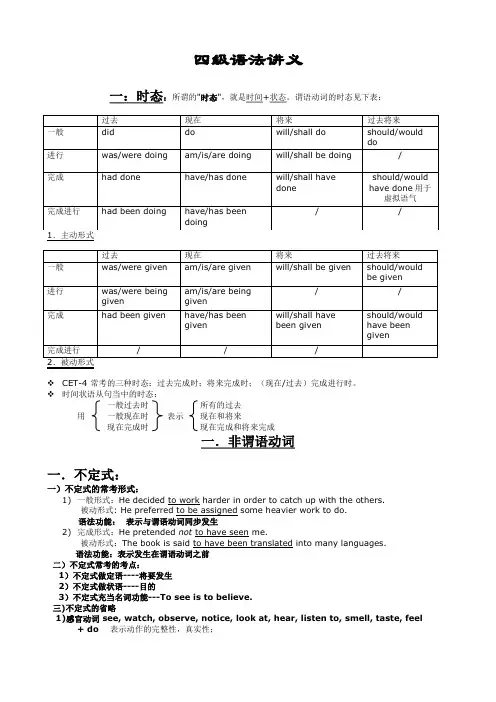
四级语法讲义一:时态:所谓的"时态",就是时间+状态。
谓语动词的时态见下表:1.主动形式2.被动形式CET-4 常考的三种时态:过去完成时;将来完成时;(现在/过去)完成进行时。
时间状语从句当中的时态:一般过去时所有的过去用一般现在时表示现在和将来现在完成时现在完成和将来完成一.非谓语动词一.不定式:一)不定式的常考形式:1)一般形式:He decided to work harder in order to catch up with the others.被动形式: He preferred to be assigned some heavier work to do.语法功能:表示与谓语动词同步发生2)完成形式:He pretended not to have seen me.被动形式:The book is said to have been translated into many languages.语法功能:表示发生在谓语动词之前二)不定式常考的考点:1)不定式做定语----将要发生2)不定式做状语----目的3)不定式充当名词功能---To see is to believe.三)不定式的省略1)感官动词 see, watch, observe, notice, look at, hear, listen to, smell, taste, feel+ do表示动作的完整性,真实性;+ doing表示动作的连续性,进行性I saw him work in the garden yesterday.昨天我看见他在花园里干活了。
(强调"我看见了"这个事实)I saw him working in the garden yesterday.昨天我见他正在花园里干活。
(强调"我见他正干活"这个动作)感官动词后面接形容词而不是副词:The cake tastes good; It feels comfortable.2) 使役动词 have bid make let 等词后不定式要省略但同1)一样被动以后要还原toI ‘d like to have John do it.I have my package weighed.Paul doesn’t have to be mad e to learn.3) help help sb do help sb to do help do help to do四)有些动词后只跟不定式如:want,wish,hope,manage,promise,refuse,pretend,plan, offer,decide,agree,expect allow sb to do, cause sb to do , permit sb to do, enable sb to doforce sb to do. be more likely to do love to do warn sb to do be able to dobe ambitious to do. begin to do . start to do五) 有的时候to后面要接-ing形式accustom (oneself) to; be accustomed to; face up to; in addition to; look forward to; object to; be reduced to; resign oneself to; be resigned to; resort to; sink to; be used to; be alternative to; be close/closeness to; be dedication/dedicated to; be opposition/opposed to; besimilarity/similar to.三、need/want 后的-ing形式具有被动的意思。
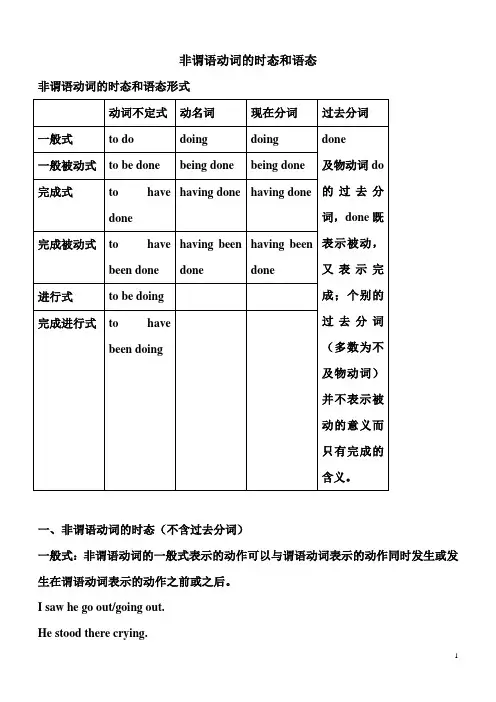
非谓语动词的时态和语态非谓语动词的时态和语态形式一、非谓语动词的时态(不含过去分词)一般式:非谓语动词的一般式表示的动作可以与谓语动词表示的动作同时发生或发生在谓语动词表示的动作之前或之后。
I saw he go out/going out.He stood there crying.He insisted on joining the army.Thank you for giving us so much help.完成式:非谓语动词的完成式表示的动作发生在谓语动词表示的动作之前I am sorry to have kept you waiting.He was praised for having taught for 60 years.Having finished the work he went home.不定式的完成式和完成进行式:只有动词不定式有这两种时态。
其进行式表示的动作正在进行,与谓语动词表示的动作同时发生;其完成进行式表示的动作在谓语动词表示的动作之前一直进行。
They seems to be getting along well now.We’re happy to have been working with you.二、非谓语动词的语态(不含过去分词)一般被动式I’m glad to be invited here.He did it without being asked.The building being built is our school.The book is said to have been translated into chinese.It’ said that 据说…sb./sth. be said to do sth.据说某人某物…She has no memory of having been praised.The plan having been made, he carried it out at once.。
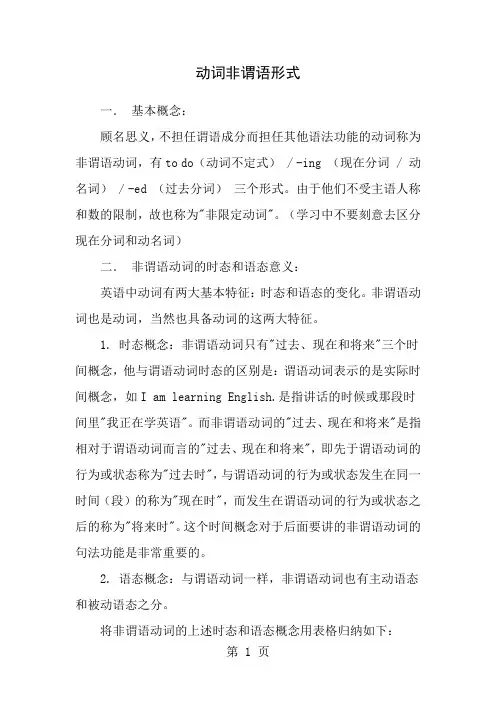
动词非谓语形式一.基本概念:顾名思义,不担任谓语成分而担任其他语法功能的动词称为非谓语动词,有to do(动词不定式) / -ing (现在分词 / 动名词) / -ed (过去分词)三个形式。
由于他们不受主语人称和数的限制,故也称为"非限定动词"。
(学习中不要刻意去区分现在分词和动名词)二.非谓语动词的时态和语态意义:英语中动词有两大基本特征:时态和语态的变化。
非谓语动词也是动词,当然也具备动词的这两大特征。
1. 时态概念:非谓语动词只有"过去、现在和将来"三个时间概念,他与谓语动词时态的区别是:谓语动词表示的是实际时间概念,如I am learning English.是指讲话的时候或那段时间里"我正在学英语"。
而非谓语动词的"过去、现在和将来"是指相对于谓语动词而言的"过去、现在和将来",即先于谓语动词的行为或状态称为"过去时",与谓语动词的行为或状态发生在同一时间(段)的称为"现在时",而发生在谓语动词的行为或状态之后的称为"将来时"。
这个时间概念对于后面要讲的非谓语动词的句法功能是非常重要的。
2. 语态概念:与谓语动词一样,非谓语动词也有主动语态和被动语态之分。
将非谓语动词的上述时态和语态概念用表格归纳如下:也就是要记住四句话:(1) 表示将来时;(2) 表示现在时;(3) 表示过去时(一定是被动的)(4) 动词不定式的完成时表示过去时非谓语动词的上述时态和语态概念是理解非谓语动词句法功能、应试判题和翻译的基础。
请你判断一下,下面句子中的非谓语动词是什么时态和语态:Your duty is to look after the sick child. (你的责任是照料这个病孩。
将来 / 主动)The sick child needs to be looked after by a special person. (这个病孩需要专人照顾。
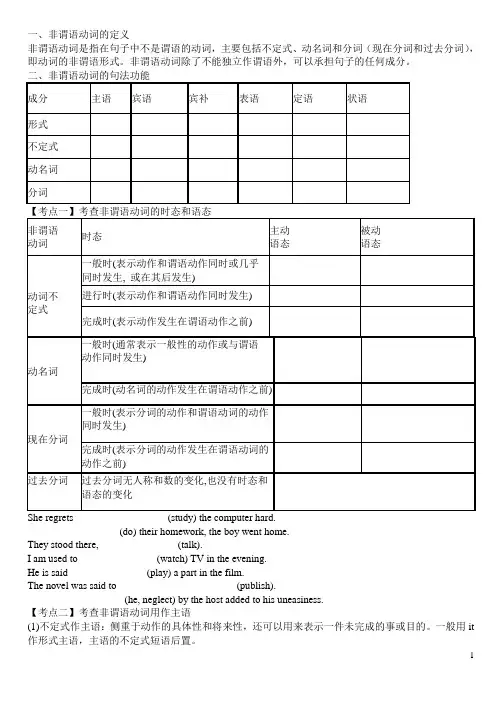
一、非谓语动词的定义非谓语动词是指在句子中不是谓语的动词,主要包括不定式、动名词和分词(现在分词和过去分词),即动词的非谓语形式。
非谓语动词除了不能独立作谓语外,可以承担句子的任何成分。
__________________(do) their homework, the boy went home.They stood there, _______________(talk).I am used to _______________(watch) TV in the evening.He is said _______________(play) a part in the film.The novel was said to _______________________(publish).___________________(he, neglect) by the host added to his uneasiness.【考点二】考查非谓语动词用作主语(1)不定式作主语:侧重于动作的具体性和将来性,还可以用来表示一件未完成的事或目的。
一般用it 作形式主语,主语的不定式短语后置。
(2)动名词作主语:表示抽象动作,还可以表示一件已知的事或经验。
动词-ing形式作主语时,谓语动词要用单数形式。
注意:动名词作主语时,常用it作形式主语,用于以下句型:It is no use/no good/fun/a waste of time/a good pleasure ... +doingIt is useless/good/worthwhile ... +doingIt is not very good for you_____________( smoke) so much.(具体)It took me only five minutes ____________(finish) the job.It is fun __________________(play) chess with Jack.I don’t mind ____________ (he, go)._________________(They, come) to help was a great.There is no _________________(deny) that she is very efficient.【考点三】考查非谓语动词用作状语(1)不定式作状语①不定式作目的状语:in order (not) to(可放在句首,也可放在句中);so as (not) to(只能放在句中)。
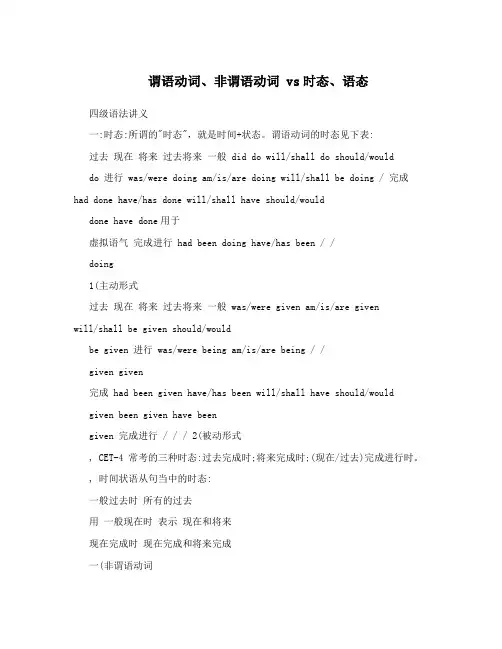
谓语动词、非谓语动词 vs时态、语态四级语法讲义一:时态:所谓的"时态",就是时间+状态。
谓语动词的时态见下表:过去现在将来过去将来一般 did do will/shall do should/woulddo 进行 was/were doing am/is/are doing will/shall be doing / 完成had done have/has done will/shall have should/woulddone have done用于虚拟语气完成进行 had been doing have/has been / /doing1(主动形式过去现在将来过去将来一般 was/were given am/is/are givenwill/shall be given should/wouldbe given 进行 was/were being am/is/are being / /given given完成 had been given have/has been will/shall have should/wouldgiven been given have beengiven 完成进行 / / / 2(被动形式, CET-4 常考的三种时态:过去完成时;将来完成时;(现在/过去)完成进行时。
, 时间状语从句当中的时态:一般过去时所有的过去用一般现在时表示现在和将来现在完成时现在完成和将来完成一(非谓语动词一(不定式:一)不定式的常考形式:1) 一般形式:He decided to work harder in order to catch up with the others.被动形式: He preferred to be assigned some heavier work to do.语法功能: 表示与谓语动词同步发生2) 完成形式:He pretended not to have seen me.被动形式:The book is said to have been translated into many languages.语法功能:表示发生在谓语动词之前二)不定式常考的考点:1)不定式做定语----将要发生2)不定式做状语----目的3)不定式充当名词功能---To see is to believe.三)不定式的省略1)感官动词 see, watch, observe, notice, look at, hear, listen to, smell, taste, feel+ do 表示动作的完整性,真实性;+ doing 表示动作的连续性,进行性I saw him work in the garden yesterday.昨天我看见他在花园里干活了。
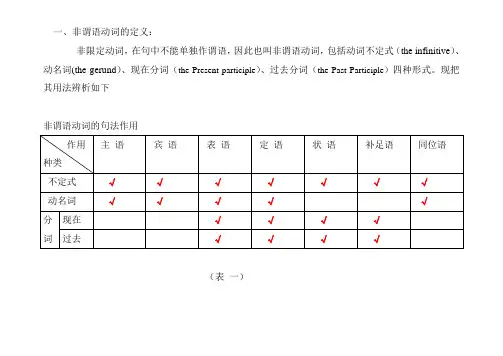
一、非谓语动词的定义:非限定动词,在句中不能单独作谓语,因此也叫非谓语动词,包括动词不定式(the infinitive)、动名词(the gerund)、现在分词(the Present participle)、过去分词(the Past Participle)四种形式。
现把其用法辨析如下非谓语动词的句法作用(表一)二.非谓语动词的时态和语态:1.不定式的时态和语态(表二)(表三)(表四)通过上述几个表格的比较,我们可以知道四种非谓语动词的时态和语态形式,下面我们再总结一下:1.非谓语动词的否定式:一律直接在非谓语动词之前加not 即可。
例如:(1)The doctor advised me not to smoke.(2)I regret not having gone together with her.(3)Not having been there before, I don’t know the shortest way to the railway station.(4)Not educated well, he found it difficult to solve such a complicate problem.2.非谓语动词的完成式:不定式的否定式我们只要在原来不定式中的动词之前加have即可,然后把原来的动词变为它的过去分词即可,如to do→not have done. 而过去分词只有一种形式,即done.下面我们重点来看现在分词和动名词的完成形式。
现在分词和动名词完成形式是完全一样的,其变化规律是:一律在现在分词或动名词的一般式之前加having→having done,再把原来的现在分词或动名词变为它的过去分词。
如stud y →having studied3.非谓语动词的被动式:不定式的被动:看表二现在分词和过去分词的被动:看表三动名词的被动:看表四从第二点我们可以知道现在分词和过去分词都可以表被动,那么他们有什么区别?区别:现在分词的被动形式除了可以表示被动之外,还可以表示进行过去分词除了表示被动之外还可以表示完成例如:(1)The house being built now will be a hospital.(2) The house built last year is a hospital.下面我们重点讨论一下现在分词和过去分词在句子中的用法。
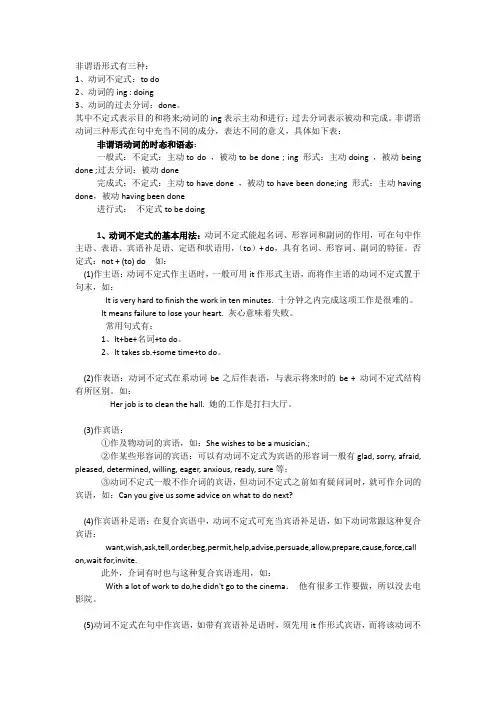
非谓语形式有三种:1、动词不定式:to do2、动词的ing : doing3、动词的过去分词:done。
其中不定式表示目的和将来;动词的ing表示主动和进行;过去分词表示被动和完成。
非谓语动词三种形式在句中充当不同的成分,表达不同的意义,具体如下表:非谓语动词的时态和语态:一般式:不定式:主动to do ,被动to be done ; ing 形式:主动doing ,被动being done ;过去分词:被动done完成式:不定式:主动to have done ,被动to have been done;ing 形式:主动having done,被动having been done进行式:不定式to be doing1、动词不定式的基本用法:动词不定式能起名词、形容词和副词的作用,可在句中作主语、表语、宾语补足语、定语和状语用,(to)+ do,具有名词、形容词、副词的特征。
否定式:not + (to) do 如:(1)作主语:动词不定式作主语时,一般可用it作形式主语,而将作主语的动词不定式置于句末,如:It is very hard to finish the work in ten minutes. 十分钟之内完成这项工作是很难的。
It means failure to lose your heart. 灰心意味着失败。
常用句式有:1、It+be+名词+to do。
2、It takes sb.+some time+to do。
(2)作表语:动词不定式在系动词be之后作表语,与表示将来时的be + 动词不定式结构有所区别。
如:Her job is to clean the hall. 她的工作是打扫大厅。
(3)作宾语:①作及物动词的宾语,如:She wishes to be a musician.;②作某些形容词的宾语:可以有动词不定式为宾语的形容词一般有glad, sorry, afraid, pleased, determined, willing, eager, anxious, ready, sure等;③动词不定式一般不作介词的宾语,但动词不定式之前如有疑问词时,就可作介词的宾语,如:Can you give us some advice on what to do next?(4)作宾语补足语:在复合宾语中,动词不定式可充当宾语补足语,如下动词常跟这种复合宾语:want,wish,ask,tell,order,beg,permit,help,advise,persuade,allow,prepare,cause,force,call on,wait for,invite.此外,介词有时也与这种复合宾语连用,如:With a lot of work to do,he didn't go to the cinema.他有很多工作要做,所以没去电影院。

非谓语动词的时态区别掌握非谓语动词在不同时态中的区别非谓语动词是指在句子中所起的动词作用,但不作为谓语动词。
它可以是动词的不定式、现在分词和过去分词形式。
在不同的时态中,非谓语动词的形式和用法有所不同,掌握这些差异对于正确使用非谓语动词十分重要。
一、不定式(Infinitive)不定式是非谓语动词的一种形式,它通常由“to + 动词原形”构成。
不定式有三种不同的时态形式,即一般式(Simple)、进行式(Progressive)和完成式(Perfect)。
1. 一般式(Simple)不定式的一般式表示动作或状态的简单事实。
它通常用于以下情况:- 表示客观事实或普遍真理:To learn is to grow.(学习就是成长。
)- 用于目的状语从句:I went to the store to buy some groceries.(我去商店买些食品。
)2. 进行式(Progressive)不定式的进行式表示正在进行的动作或状态。
它通常用于以下情况:- 表示将来进行时:He is going to leave soon.(他马上要离开了。
)- 表示习惯性行为:He goes running every morning.(他每天早上去跑步。
)3. 完成式(Perfect)不定式的完成式表示已经完成的动作或状态。
它通常用于以下情况:- 表示意图或目的:He came to see you.(他来看你。
)- 表示对过去发生事件的叙述:I was surprised to hear the news.(听到这个消息我感到很惊讶。
)二、现在分词(Present Participle)现在分词是非谓语动词的一种形式,它通常由动词的现在分词形式(动词原形 + ing)构成。
现在分词常用于进行式和描述性质等情况。
1. 进行式(Progressive)现在分词的进行式表示正在进行或进行的动作。
它通常用于以下情况:- 描述当前状态或动作:She was sitting in the park, reading a book.(她坐在公园里,看着一本书。
非谓语动词的时态和语态的转换非谓语动词是指不带有人称和数的动词形式,主要包括动词不定式、动名词和现在分词。
在使用非谓语动词时,我们需要注意时态和语态的转换问题。
本文将详细介绍非谓语动词的时态和语态的转换方式,并给出一些使用示例。
一、动词不定式的时态和语态转换1. 一般时态转换:(1)主动形式的一般时态转为被动形式:to be + 过去分词例:I want to buy a new car.(我想买一辆新车。
)→ I want a new car to be bought.(我想要一辆新车被买。
)(2)被动形式的一般时态转为主动形式:to have done(表示将来完成)例:The house will be cleaned by me.(这个房子将会被我打扫。
)→ I will have cleaned the house.(我将会打扫这个房子。
)2. 进行时态转换:(1)主动形式的进行时态转为被动形式:to be + being + 过去分词例:She is singing a song.(她正在唱歌。
)→ A song is being sung by her.(一首歌正在被她唱。
)(2)被动形式的进行时态转为主动形式:to have been being + 过去分词例:The room was being cleaned by the maid.(这个房间正在被女仆打扫。
)→ The maid had been cleaning the room.(女仆一直在打扫这个房间。
)3. 完成时态转换:(1)主动形式的完成时态转为被动形式:to have been + 过去分词例:We have finished the project.(我们已完成这个项目。
)→ The project has been finished by us.(这个项目已由我们完成。
)(2)被动形式的完成时态转为主动形式:to have + done例:The book has been read by him.(这本书已被他阅读。
非谓语动词时态和语态的结构1. 不定式有哪些时态和语态呢?主动被动一般时to do to be done进行时to be doing 无完成时to have done to have been done 完成进行式to have been doing 无2. 动名词的时态和语态主动被动一般时doing being done完成时having done having been done 3. 分词的时态和语态主动被动现在分词一般时doing being done现在分词完成时having done having been done 过去分词无done中考英语非谓语动词总结一.接动词不定式(to do/ do sth)1. do nothing but do sth除了做某事外不做任何事2. be supposed to do sth应该做某事;被期望干某事3. Let's (not ) do sth4.want to do sth5.want sb to do sth7.ask sb (not ) to do sth8.stop to do sth停下来去做某事9.tell sb (not ) to do sth10.watch sb do sth观察某人做某事11.It's time (for sb) to do sth到了该去做某事的时间12.help sb (to ) do sth13.help do sth14.make sb do sth15.decide (not ) to do sth决定做某事16.find it +adj + to do sth17.have to do sth必须做某事18.try (not ) to do sth尽力做某事19.try one's best to do sth尽某人最大能力做某事20.It's +adj +(for)of +sb + to do sth21.plan to do sth计划去做某事22.S.p.+be a good place to do sth23.It takes sb +some time + to do sth做某事花费某人多长时间24.send sb to do sth派某人做某事25.invite sb to do sth邀请某人做某事26.forget to do sth忘记要去做某事27.live to be +时间活到…28.be able to do sth能够做某事29.have sth to do 有事要做30.seem to do sth似乎做;好像31.get sb /sth to do sth32.疑问词+ to do sth33.need sth to do sth需要……做某事e sth to do sth用某物来做某事35.follow sb to dosth跟随某人做某事36.need to do sth需要做某事37.a good time to do sth做某事的好时候38.the best time to do sth 做某事的最好时间39.the best way to do sth做某事最好的方法40.be the first / last one to do sth最后一个或者第一个(人或事吧)去做某事41.would like to do sth想要做某事42.be excited /surprised to do sth对做某事感到兴奋43.be useful to do sth有助于做某事44.be allowed to do sth被允许做某事45.allow sb to do sth允许某人做某事46.It's better to do sth干某事比较好47.It's best to do sth48.take care (not) to do sth小心(不要)做某事49.see sb do sth看见某人做了某事50.why not do sth ?51.have enough time to do sth有足够的时间干某事52.too…to do sth太…以至于不能53.not…enough to do sth 不-----足够做某事54.encourage sb to do sth鼓励某人做某事55.choose to do sth选择做某事56.wait to do sth等着做某事57.be happy/glad/pleased to do sth高兴做某事58.make it +adj + to do sth59.be careful to do sth小心做某事60.be afraid to do sth害怕去做某事61.It's our duty to do sth做某事是我们的责任ed to do sth过去常做某事63.can't afford to do sth不能担负起干某事64.make a decision to do sth决定做某事65.have an opportunity to do sth有做某事的机会66.wait for sb to do sth等待某人做某事67.would do sth rather than do sth宁愿做某事不愿做某事68.would rather do sth than do sth宁愿做某事不愿做某事69.hurry to do sth匆忙去做某事70.refuse to do sth拒绝干某事71.agree to do sth同意干某事72.pretend to do sth假装做某事73.pretend to be doing sth假装正在做某事74.prefer to do sth更喜欢做某事75.prefer not to do sth76.prefer to do sth raher than do sth77.be willing to do sth乐意去做某事78.volunteer +时间/ 钱+ to do sth79.volunteer to do sth自愿去做某事80.offer to do sth提出要做…81.rush to do sth赶着做某事82.in order (not ) to do sth为了做某事83.be certain to do sth一定做…84.be sure to do sth一定会做某事85.make plans to do sth制定计划做某事86.go out of one’s way to do sth特别费心地(为某人)做某事87.lead sb to do sth致使某人做某事88. warn sb to do sth警告某人做某事89.It's one's turn to do sth该轮到某人做某事90.urge sb to do sth敦促某人做某事91.Could /Would you please (not) do sth ? 请你(不要)做某事好吗?92.it is great fun to do sth做…很有趣二、接动名词(doing sth)1.like doing sth3.have great fun doing sth做…玩得很高兴4.be interested in doing sth对做某事感兴趣5.Thanks for doing sth感谢某人做某事6.look at sb doing sth看到某人做某事7.stop sb doing sth阻止某人做某事8.stop sb from doing sth阻止某人做某事9.go + v-ing10.do the (some )+v-ing11.What/How doing sth ?12.practice doing sth练习做某事13.watch sb doing sth观察某人正在做某事14.find sb doing sth发现某人正在做某事15.mind (one's ) doing sth介意(某人)做某事。
非谓语动词的时态与语态在英语语法中,非谓语动词是指不带有主语和谓语关系的动词形式。
它们包括动词不定式、动名词和分词。
而非谓语动词的时态和语态往往是我们学习过程中容易混淆的地方。
本文将针对非谓语动词的时态和语态进行探讨,帮助读者更好地理解和运用。
一、动词不定式时态与语态动词不定式是主动形式和被动形式一致的,无人称和数的变化。
即使在被动句中,不定式的形式也保持不变。
例如:- 主动形式:to eat(吃)- 被动形式:to be eaten(被吃)动词不定式没有时态的变化,所以它常常用来表示和主句谓语动词同时或者稍晚发生的动作。
例如:- I hope to see you tomorrow.(我希望明天见到你。
)- She promises to help me with my homework tonight.(她答应今天晚上帮我做作业。
)此外,动词不定式还可以用来表示含义上的将来、远将来以及可能发生的动作。
例如:- He plans to travel to Europe next year.(他计划明年去欧洲旅行。
)- I hope to win the lottery someday.(我希望有一天中彩票。
)二、动名词时态与语态动名词在时态和语态上与现在分词相同。
例如:- 主动形式:singing(唱歌)- 被动形式:being sung(被唱)相对于动词不定式,动名词可以表示更早的动作。
例如:- After finishing her work, she went home.(她把工作完成后,回家了。
)- He admitted stealing the money.(他承认偷了那笔钱。
)动名词也可以表示同时进行的动作或者是取决于主句谓语动词发生的动作。
例如:- I love swimming in the ocean.(我喜欢在海里游泳。
)- He enjoys listening to music while studying.(他喜欢一边学习一边听音乐。
非谓语动词语法讲解一、非谓语动词的概念 动词的基本用法是作谓语。
当句中已经有了谓语动词了,要选或 要填的动词就只能用非谓语形式了。
非谓语形式有三种:1、动词不定式:to do 2、动词的 ing : doing 3、 动词的过去分词:done二、三种形式的含义(基本用法) 不定式:表示目的和将来;动词的 ing:表示主动和进行;过去 分词:表示被动和完成。
三、非谓语动词的时态和语态 一般式 不定式 主动 to do 完成式 to have done 被动 to be done to have been done ing 形 主动 式 被动 doing being done having done having been done 进行式 to be doing过去分 被动 词done四、非谓语动词的否定形式 在非谓语动词前加 not, never. 即 not / never to do, not / never doing 五、非谓语动词的复合结构 不定式的复合结构:for / of sb. to do sth. 动词 ing 形式的复合结构:宾格或所有格+doing (-ing 形式作 主语时,用的所有格+doing) 六、非谓语动词的做题步骤 1、判定是否用非谓语形式。
方法:看看句子中是否已有了谓语 动词了 2、找非谓语动词的逻辑主语。
方法:非谓语动词的逻辑主语一 般是句子的主语。
3、判断主被动关系。
方法:非谓语动词与其逻辑主语的主动还 是被动关系。
4、判断时间关系。
方法:分析句子,看看非谓语动词所表示的 动作发生在谓语动作之前、之后还是同时。
之前常用 done; 之后常用 to do; 同时常用 doing. 学习非谓语形式时,建议把三种形式一起来比较学习,会更加有 效一些。
一、非谓语动词作主语和表语的比较 1、不定式和动名词作主语和表语 a. 不定式表示一次性的、具体的动词。
中的非谓语动词的时态和语态变化规则非谓语动词是指动词的非谓语形式,包括不定式、动名词和分词。
在句子中,非谓语动词有时态和语态的变化规则。
本文将讨论中的非谓语动词的时态和语态变化规则。
时态变化规则:1. 不定式:中的不定式常用于表示目的、结果、原因等,不定式的时态不随主要谓语动词的时态而变化。
例如:- They went to the park to play.(他们去公园玩。
)- She wants to learn English.(她想学英语。
)2. 动名词:中的动名词通常表示动作、状态等,动名词的时态与主要谓语动词的时态保持一致。
例如:- He enjoys swimming in the lake.(他喜欢在湖里游泳。
)- I am considering buying a new car.(我正在考虑买一辆新车。
)3. 分词:中的分词作定语、表语或状语,根据上下文需要,分词的时态主要有以下几种形式:- 一般现在分词:表示主动、客观,与主语的时态一致。
例如:- The running water sounds pleasant.(流动的水听起来很悦耳。
)- The book being read by the students is mine.(学生们正在读的书是我的。
)- 过去分词:表示被动、完成或状态,根据上下文需要,可能需要加上助动词“be”,并与主语的时态一致。
例如:- The broken vase was thrown away.(被打破的花瓶被扔掉了。
)- I have finished the work assigned by the manager.(我已经完成了经理分配给我的工作。
)语态变化规则:1. 不定式的语态变化较为简单,一般使用主动语态,常用形式为“to + 动词原形”。
如果需要使用被动语态,可以使用“to be + 动词的过去分词”形式。
例如:- He wants to go to the library.(他想去图书馆。